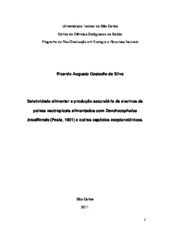Seletividade alimentar e produção secundária de alevinos de peixes neotropicais alimentados com Dendrocephalus brasiliensis (Pesta, 1921) e outras espécies zooplanctônicas
Abstract
The hatchery is now the main obstacle of aquaculture. The live food, especially zooplankton, is essential in early life stages of fish. However, there are difficulties in obtaining enough biomass. The Anostraca Dendrocephalus brasiliensis, known as branconeta, has great potential of use in national aquaculture. In this study, it was performed experiments of food selectivity and secondary production with fingerlings of matrinxã (Brycon cephalus) and pintado-da-amazônia, a hybrid between Pseudoplatystoma corruscans and Leiarius marmoratus, using D. brasiliensis and other species of zooplankton as food. Food selectivity results were evaluated using the Ivlev selectivity index and the coefficient of food Paloheimo. For both species, the indexes of the juveniles indicated a preference by D. brasiliensis in comparison to zooplankton. Secondary production values were better when matrinxã was fed with Artemia plus artificial food; there was no significant difference to fish fed with branconeta. For pintado-da-amazônia, the highest production was obtained from branconeta treatment. So, the selectivity for D. brasiliensis is positive, once it was accepted by both species, without rejection. The results allow us to assert that the use of D. brasiliensis is suitable for the cultivation of both species.
